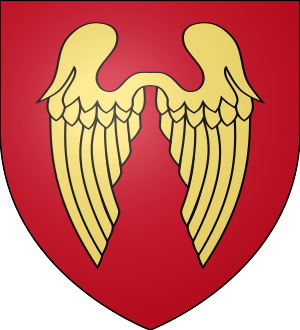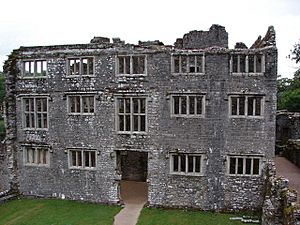Sir Edward Seymour, 2nd Baronet facts for kids
Quick facts for kids
Sir Edward Seymour, 2nd Baronet
|
|
|---|---|

Arms of Seymour of Seymour of Berry Pomeroy: Gules, two wings conjoined in lure or. The Seymour line of Berry Pomeroy did not inherit the special grant of arms made to the 1st Duke of Somerset, which descended to the children from his second marriage
|
|
| Born | c. 1580 |
| Died | 5 October 1659 Berry Pomeroy
|
| Spouse(s) | Dorothy Killegrew |
| Parent(s) | Sir Edward Seymour, 1st Baronet Elizabeth Champernowne |
Sir Edward Seymour, 2nd Baronet (born around 1580, died 5 October 1659) was an important English landowner and politician. He served in the English Parliament, called the House of Commons, for many years between 1601 and 1625. He also worked as an ambassador, representing England in Denmark. During the English Civil War, he supported the King's side, known as the Royalists.
Contents
Early Life and Family
Edward Seymour was born around 1580. His father was Sir Edward Seymour, 1st Baronet, who lived in a place called Berry Pomeroy. His mother was Elizabeth Champernowne. Her father was Sir Arthur Champernowne.
A Career in Politics
Edward Seymour started his political career in 1601. He was chosen to be a Member of Parliament (MP) for Penryn. An MP is someone elected to represent people in the country's government.
In 1603, King James I made him a knight. This meant he was given the title "Sir." The King also sent him to Denmark as an ambassador. An ambassador is like a special messenger. They represent their country in another country.
Serving in Parliament
Sir Edward continued to be an MP for many different areas. In 1604, he was elected for Newport. When his father passed away in 1613, Edward became the 2nd Baronet. This was a special title that passed down in his family. He also became the governor of Dartmouth that same year.
He was elected MP for Lyme Regis in 1614. He also worked as a Justice of the Peace for Devon. This meant he helped keep law and order. From 1617, he was the Vice Admiral of Devon. This was an important role in charge of naval matters in the area.
He continued serving as an MP. He was elected for Devon in 1621. Later, he represented Callington in 1624. His last time as an MP was for Totnes in 1625.
The English Civil War
Sir Edward Seymour was an official for the Admiralty. This was the part of the government that managed the navy. He also worked as a privateer. This meant he had permission to attack enemy ships during wartime.
During the English Civil War, Sir Edward was a Royalist. This meant he supported King Charles I. Sadly, he and his son were captured in Plymouth. Their family home, Berry Pomeroy Castle, was destroyed during the war.
After the war, he had to pay a large sum of money. This was to people who took over the estates of Royalist supporters.
Family Life
Sir Edward Seymour married Dorothy Killigrew in 1600. She was the daughter of Sir Henry Killigrew. Dorothy passed away in 1643. They had seven children together.
Their children included:
- Sir Edward Seymour, 3rd Baronet (1610–1688)
- Henry Seymour (1612–1686)
- Thomas Seymour, who married Anne Anderson.
- Sir Joseph Seymour, who married Bridget Anderson.
- Elizabeth Seymour, who married Francis Courtenay. She later married Sir Amos Meredyth.
- Mary Seymour, who married Sir Jonathan Trelawny, 2nd Baronet. She was the mother of a famous bishop.
- Margaret Seymour, who married Francis Trelawny.
Later Years and Passing
Sir Edward Seymour passed away at his home in Berry Pomeroy. This was on 5 October 1659.


